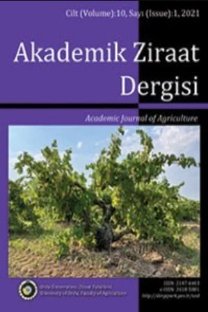Xenon Test Cihazıyla Işığa Maruz Bırakılan β-Karoten Takviyeli Fındık Yağının Oksidasyon Kararlılığı
Fındık yağı, β-karoten, oksidatif stabilite, ransimat, ışığa maruz kalma
Oxidation Stability of Hazelnut Oil Supplemented with β-Carotene During Light Exposure Using Xenon Test Instrument
Hazelnut oil, β-carotene, oxidative stability, rancimat, light exposure,
___
- Alasalvar, C., Shahidi, F., Liyanapathirana, C. M., & Ohshima, T. (2003). Turkish Tombul Hazelnut (Corylus avellana L.). 1. Compositional Characteristics. J. Agric. Food Chem., 51(13), 3790-3796.
- Alasalvar, C., Amaral, J. S., & Shahidi, F. (2006). Functional Lipid Characteristics of Turkish Tombul Hazelnut (Corylus avellana L.). Journal of Agricultural and Food Chemistry, 54, 10177-10183.
- Alasalvar, C., & Shahidi, F. (2009). Tree Nuts: Composition Phytochemicals and Health Effects. Taylor & Francis Group Boca Raton London New York: CRC Press.
- Belitz, H.D., Grosch, W., & Schieberle, P. (2008). Lehrbuch der Lebensmittelchemie. 6.Auflage, Springer-Verlag Berlin, Heidelberg.
- Crews, C., Hough, P., Godward, J., Brereton, P., Lees, M., Guiet, S., & Winkelmann, W. (2005). Study of the Main Constituents of Some Authentic Hazelnut Oils. Journal of Agricultural and Food Chemistry, 53(12), 4843–4852.
- Codex Standard, (1981). Codex Standard for Edible Fats and Oils. 19.
- FOODLAB (2007) Foodlab fat v 1.0, Betriebsanleitung, Copyright by Ing. Büro J.Schenne. Hamburg,Germany.
- Doerffel, K. (1987). Statistik in der Analytischen Chemie, VCH Verlagsgesellschaft, Weinheim.
- Frankel, E.N. (2005). Lipid Oxidation. 2. Ausgabe, The Oily Press, Bridgwater.
- Frede, W. (2010). Handbuch für Lebensmittelchemiker, Lebensmittel, Bedarfsgegenstände, Kosmetika, Futtermittel. SpringerVerlag Berlin, Heidelberg.
- Goulson, M.J., & Warthesen, J.J. (1999). Stability and antioxidant activity of beta carotene in conventional and high oleic canola oil. Journal of Food Science, 64(6), 996-999.
- Jung, M.Y., & Min, D.B. (1991). Effects of quenching mechanisms of carotenoids on the photosensitized oxidation of soybean oil. Journal of the American Oil Chemists' Society, 68(9), 653-658.
- Krist, S., Buchbauer, G., & Klausberger, C. (2008). Lexikon der pflanzlichen Fette und Öle. Springer Verlag, Wien. Köksal, A.I., Artik, N., Şimşek, A., & Güneş, N. (2006). Nutrient composition of hazelnut (Corylus avellana L.) varieties cultivated in Turkey. Food Chemistry, 99(3), 509-515.
- Petersen, K.D., Kleeberg, K.K., Jahreis, G., Busch‐Stockfisch, M., & Fritsche, J. (2012). Comparison of analytical and sensory lipid oxidation parameters in conventional and high‐oleic rapeseed oil. European Journal of Lipid Science and Technology, 114(10), 1193-1203.
- Şahin, S. (2011). Bewertung der licht-induzierten Lipidstabilität von konventionellen und high-oleic Rapsölen supplementiert mit natürlichen Antioxidantien, Yüksek Lisans Tezi, Hamburg University of Applied Sciences, Hamburg.
- Şahin, S., Tonkaz, T., & Yarilgaç, T. (2022). Chemical composition, antioxidant capacity and total phenolic content of hazelnuts grown in different countries. Tekirdağ Ziraat Fakültesi Dergisi, 19(2), 262-270.
- Şahin, S., & Özata, A.B. (2022). Substitution of cocoa powder with hazelnut skin powder in cocoa hazelnut spreads. Journal of Food Processing and Preservation, 46(12), e17276.
- Sahin, S., Katharina P., & Jan F. (2011). Effects of quenching mechanisms of carotenoids on the photosensitized oxidation of soybean oil. European Journal of Lipid Science and Technology, 112(S1), doi: 10.1002/ejlt.201100364.
- Sergio A.R., Paiva M.D., Robert M., & Russell, M.D. (1999). β-Carotene and other carotenoids as antioxidants. Journal of the American College of Nutrition,18(5), 426-433.
- Ternes W., Täufel A., Tunger L., & Zobel M. (2005). Lebensmitellexion. Behrs-Verlag, Hamburg. Yanishlieva N.V., Raneva V.G. & Marinova, E.M. (2001) β- Carotene in sunflower oil oxidation. Grasas y Aceites, 52(1), 10-16.
- WHO (2023). https://www.who.int/initiatives/behealthy/ healthy-diet, World Health Organization Healthy Diet.
- ISSN: 2147-6403
- Yayın Aralığı: Yılda 2 Sayı
- Başlangıç: 2012
- Yayıncı: Ordu Üniversitesi Ziraat Fakültesi
Fındık Meyvesinin Farklı Kısımlarındaki Renk Değişimi
Fındık Meyvesi ile Yaprakların Mineral Bileşimleri Arasındaki İlişkiler
Burhan ÖZTÜRK, Kader SALİ, Mithat AKGÜN, Umut ATEŞ
Meryem Nur ŞENEL, Emin TAYLAN, Aysun AKAR
Tombul fındık çeşidinde yaş ve kuru meyvenin antimikrobiyal etkilerinin değerlendirilmesi
Mehtap USTA, Seda BİRYOL, Ali SOYDİNÇ
Ordu-Kumru Yöresi Fındık Bahçelerinin Toprak Verimlilik Durumlarının Belirlenmesi
Fındıkta kültürel uygulamalar: Giresun örneği
Ali TURAN, Mehmet AKGÜN, Emre KAN
‘Çetiner’ Fındık (Corylus avellana L.) Çeşidinin Fenolojik, Pomolojik ve Morfolojik Özellikleri
Fatsa (Ordu)'da Yetiştirilen 'Karafındık' Fındık Klonlarının Verim Özellikleri ve Meyve Kusurları
Serkan UZUN, Fikri BALTA, Orhan KARAKAYA, M. Fikret BALTA
Kalınkara Fındık Çeşidinde İç Meyve İriliğinin Biyoaktif Bileşikler Üzerine Etkisi
